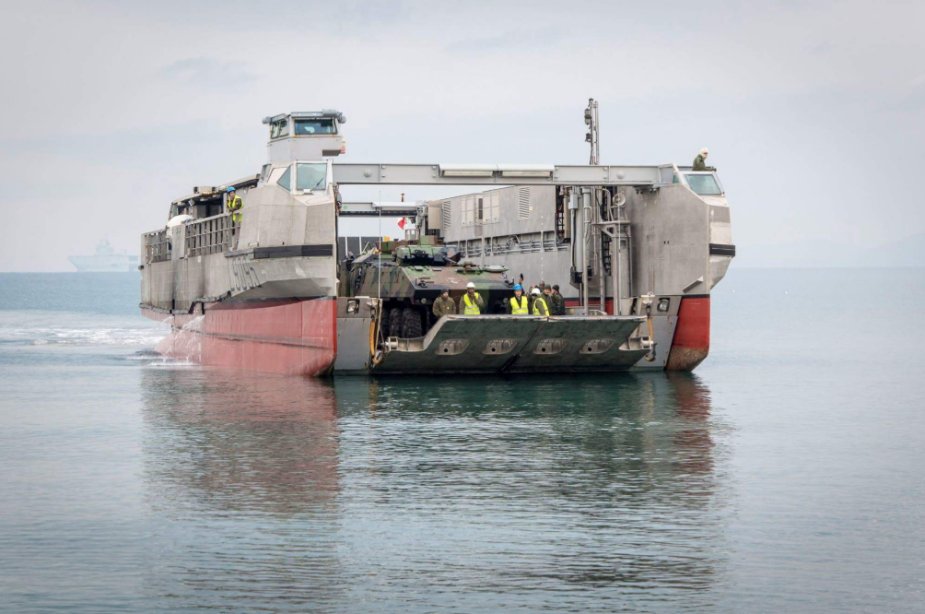In service with the French Navy since 2011 and the Egyptian Navy since 2016, CNIM’s L-CAT is now expanding its capability portfolio, the French naval equipment maker said at Euronaval 2018.
 A French Navy L-CAT landing craft
A French Navy L-CAT landing craft
(Credit: French Navy/French Armed Forces Ministry)
Widely used for anti-piracy and special operations, semi-rigid boats are a major asset to missions because of their discretion and speedness. Responding to operational requirements, CNIM – having the main aim of increasing the intervention capabilities of Forces on land and sea – has made it possible to launch and recover semi-rigid boats from the L-CAT Ship-to-Shore and Shore-to-Shore vessel.
Its easy deployment (an autonomous mobile winch and a cradle on wheels), speed (less than 3 minutes) and robust construction mean it can handle RHIBs, even in heavy seas. With a wide surface area of 127 m2, the L-CAT deck can easily accommodate large semi-rigid boats, up to 10 m and 7 tonnes.
Highly autonomous and equipped with robust self-defense systems, the L-CAT is a true asset to regional maritime safety, ensuring rapid response to illegal activity scenarios. The mothership can remain 150 nm offshore to protect it. For the deployment of special forces, CNIM amphibious craft can make a transfer up to 30 nm offshore, launching a semi-rigid boat that can make a discreet landing for as seamless mission.
For amphibious missions, docking and un-docking the amphibious vessel with the mothership are essential manoeuvres for loading and unloading men and equipment. But these are delicate and complex operations for pilots to carry out.
To ensure that docking operations are successful, CNIM has introduced a new form of training, developing a simulator for pilot training and maintaining control skills for the L-CAT craft.
Very user-friendly, the simulator is an innovative and safe solution, giving the pilot an immersive experience of docking the L-CAT in real time and in a highly realistic environment. Composed of a central unit, controls and a virtual reality helmet, the simulator gives the pilot tailored training without the need for the craft itself. The software has two modes (autonomous and interaction with an instructor) and several levels of difficulty, also offering a choice of craft (LCA, L-CAT) and motherships. Different settings also simulate difficult or dangerous situations similar to real scenarios, such as damage, deteriorated propulsion systems, tricky environmental conditions, etc.).
The simulator allows the pilot to familiarise himself with his cockpit environment (ergonomics, controls, visibility, communication equipment) and find his visual bearings for the various docking/undocking phases, helping him to automate his actions. Thanks to CNIM’s new simulator, pilots receive a quicker and more effective training.
Before amphibious missions, divers are used to securing the landing area. A drain of human resources and a potentially dangerous mission that can be carried out by an underwater robot deployed from the L-CAT. The wire-guided underwater robot has a probe and an altimeter for bathymetry, a sonar for detecting underwater obstacles and a camera for identifying type of sea bed and obstacles. Equipped with a 500 m-long cable reel, this USV weighs 24 kg and fits into a small waterproof transportable carry-case.
Designed to be reliable and user-friendly, this module can be used from any amphibious craft, beach or wharf. This robust system can be used in very shallow depths. Replacing divers, the robot provides a safe amphibious landing for Forces with a minimum use of manpower. It also drastically reduces the time needed for beach reconnaissance. It is five times quicker than divers. It can check an entire 6,0000 m2 channel in 20 minutes.










